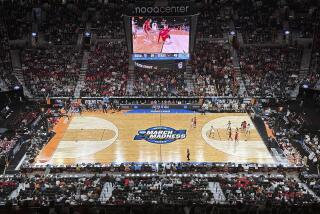How basketball reached its great height
- Share via
Question: Why is a basketball rim 10 feet above the court?
Answer: It was cold in the winter of 1891, too inclement to play football or lacrosse, and curling was for dorks. With few options to expend their adolescent energy, the kids at the YMCA Training School (now Springfield College) in Springfield, Mass., were getting rowdy. Physical education superintendent Luther H. Gulick gave instructor James Naismith two weeks to develop an indoor sport as a bridge to baseball season. Although Naismith’s 13 rules for basketball have been amended and appended, the game remains true to his vision: Put a ball in a basket, and mind your manners in the process. A renaissance man who eventually earned degrees in philosophy, religion, physical education and medicine, Naismith celebrated recreation over competition and cared far less about vertical leap than good sportsmanship. The original rules said nothing about court dimensions or the height of the hoop or waiting 100 years before tattoos became as standard-issue as rubber-soled shoes for the players. The 10-foot threshold had nothing to do with the decimal system, or the number of players on the court (Naismith called for 18, nine to a side) or any other numerical contrivance. It was simply expedient. In the gym where the game got game, Naismith hung peach baskets from an available structure -- an elevated running track that rimmed the court 10 feet above the floor. The first nine-man game between opposing colleges was Feb. 9, 1895, when Minnesota State School of Agriculture slaughtered the Hamline College Porkers, 9-3; the first five-man intercollegiate game on Jan. 16, 1896, was more Midwestern madness, the University of Chicago beating the University of Iowa, 15-12. Watching this week’s Pacific 10 tournament, you might wonder about not only hoop height, but its consistent appearance. Naismith was big on decorum, and the NCAA is big on decor. Decrees its rule book, Section 13, Article 2: “Each ring and its attaching flange and braces shall be bright orange in color.”
-- Ellen Alperstein
More to Read
Go beyond the scoreboard
Get the latest on L.A.'s teams in the daily Sports Report newsletter.
You may occasionally receive promotional content from the Los Angeles Times.










